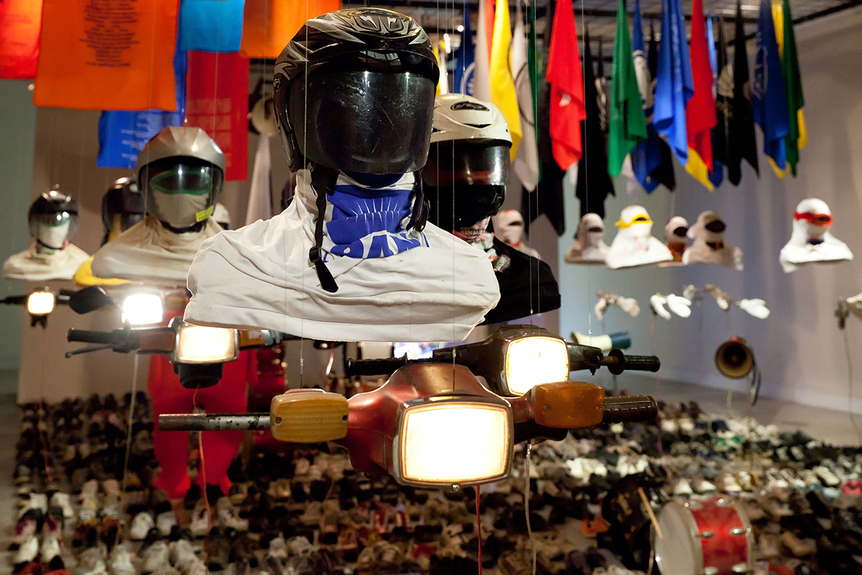-
From Current Issue
-
- Editor’s Letter Fire in the Heart
- Reviews I Gusti Ayu Kadek Murniasih
- Reviews 11th Seoul Mediacity Biennale: “One Escape at a Time”
- Dispatch Networked China
- One on One Monira Al Qadiri on Yukio Mishima
- Essays The rise of independent art spaces in pandemic-era Shanghai
- Features Tuan Andrew Nguyen
- Table of Contents
- Web Exclusives
- Archive
- Subscribe

R
E
V N
E
X
T
The voices of Indonesian contemporary artists are gaining an increasing profile in Australia along with the region. Yogyakarta is a thriving arts center, attracting artists and curators from around the region for cultural exchange. Indonesian artists appear in biennials and triennials, and are closely watched and supported by commercial galleries and collectors in Australia and elsewhere in Southeast Asia. The inaugural iteration of the Art Stage Jakarta art fair (younger sibling of Art Stage Singapore) is one recent example of this expanding profile.
Another is Jompet Kuswidananto’s major new commission After Voices (2016), the latest project to take place at the Sherman Contemporary Art Foundation (SCAF) in Sydney. Since 2008, when Gene Sherman transitioned the commercial enterprise Sherman Galleries into the not-for-profit SCAF, the Foundation has played host to 32 projects, with a focus on developing major works from artists across Australia and the Asia-Pacific, architectural commissions and curatorial reframing of artists from the Gene & Brian Sherman Collection.
JOMPET KUSWIDANANTO, After Voices, 2016, resin/latex hands, costumes, motorcycle parts, motorcycle helmets, shoes, electronics, flags, speakers, drums, video and sound, dimensions variable. Installation view at Sherman Contemporary Art Foundation (SCAF), Sydney, 2016. Courtesy SCAF.
After Voices takes the form of a procession in which everyone has vanished, leaving behind the tools of protest. Kuswidananto’s striking mixed-media installation is underpinned by hundreds of pairs of shoes which are assembled in rectangular formation through the gallery space. The shoes bear the wear and tear of footwear that has been put through its paces, and now stand to attention in lieu of their owners. Above these are suspended a number of empty busts, whose external shape is formed respectively by motorcycle helmets or balaclavas fashioned from t-shirts. The invisible figures implied by these busts are accompanied respectively by suspended motorcycle headlamps, motorized clapping “hands” and drums, and megaphones. These are the various groups active in Indonesia’s heady public clashes which, as curator Alia Swastika describes in her catalogue essay, took the place of declining student protests after the 1998 revolution—their corresponding battle cries are printed on colorful banners hanging above them, impotent without a vehicle of voice. A fan intermittently and noisily starts, fluttering large banners on which are printed figures poised to shoot. That these ghostly figures occasionally semi-appear further serves to highlight the absence of a dynamic human presence in this gathering.
Face coverings have strong connotations in the current sociopolitical climate, including in Australia where women who choose to cover their heads or faces are often subject to religious vilification, ironically sometimes by groups whose members have been known to hide their faces in the Australian flag when protesting in public. In Kuswidananto’s work, the face coverings of each invisible bust simultaneously anonymize and collectivize the individual. The strength of the public protest lies in the gathering of many singular bodies; however, it is the merging of these bodies into a large mass stripped of individual identity that creates strength—and also volatility.
The audio-visual accompaniment to the installation in After Voices is a video, portraying a re-enactment of a significant military offensive that took place in Yogyakarta on March 1, 1949, between occupying Dutch and insurgent Indonesian forces. As Swastika explains in her essay, the original event is often re-visited by Indonesians as an example of Suharto’s supposedly instrumental role in the country’s revolution. Kuswidananto has documented the event’s re-staging by a historical re-enactment society in Yogyakarta. Filmed on sites already heavy with Suharto’s self-aggrandizement in the form of monuments and a museum, the footage is a reminder of the ways history is constructed and reconstructed and protagonists are positioned and repositioned. Figures in period military costume act out battles, while onlookers in contemporary dress can be seen in the background clustered behind fences and a sign points to the museum’s car park.
In the black-and-white film Noda/Stains (2016), another video element of After Voices, a figure mops the floor, perversely spreading a dark liquid across the room. The liquid pools on the floor and drips down the side of a basin. In an installation that gathers together the physical and psychological memory of protest, this quiet yet powerful piece shines a light on the dark corners of the mind, prompting contemplation of what remains when the battle cries have faded into the distance.
“Jompet Kuswidananto: After Voices” is on view at Sherman Contemporary Art Foundation, Sydney, until September 10, 2016.






